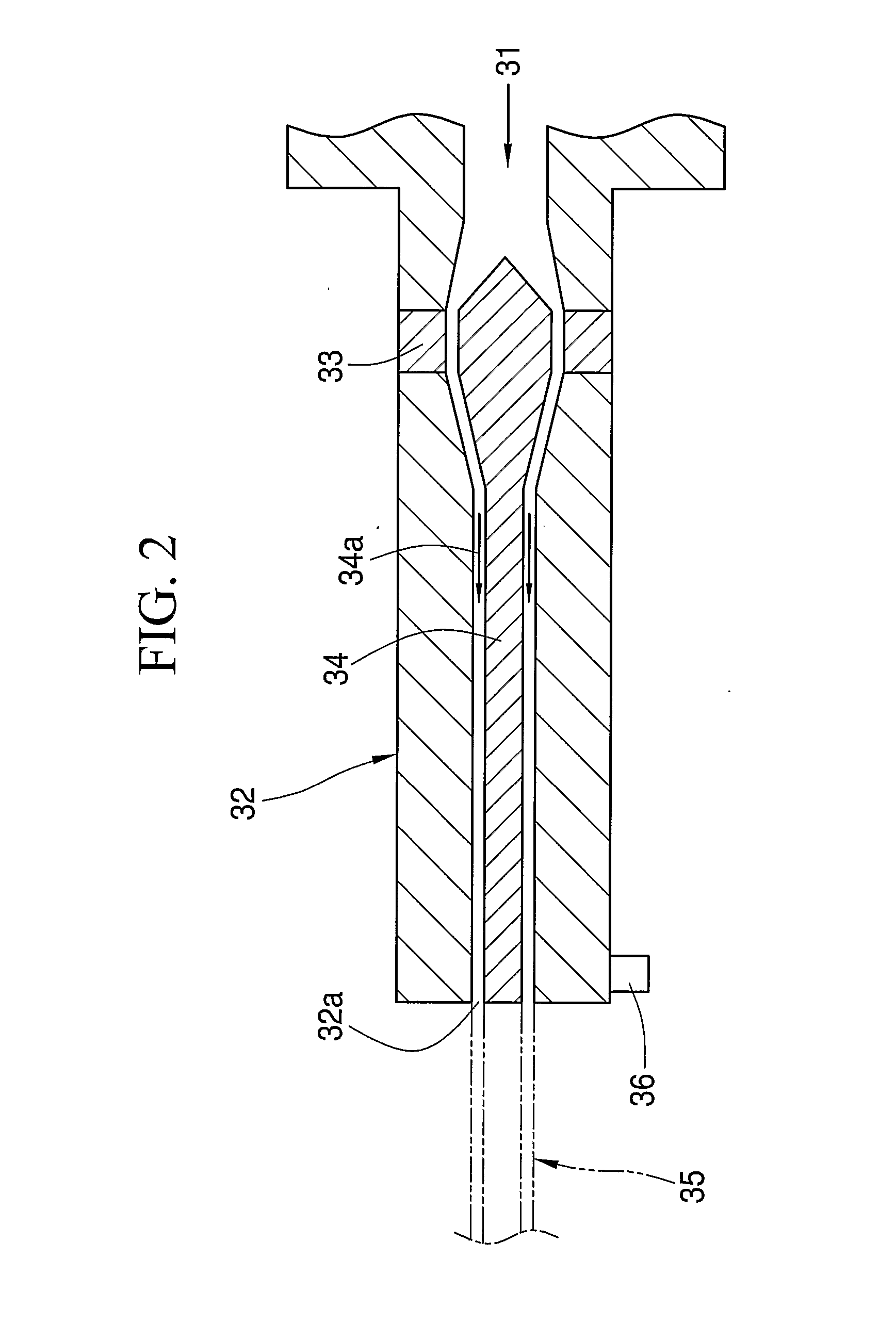Method and Apparatus for Coating Plastic Optical Fiber with Resin
a technology of plastic optical fiber and resin, which is applied in the direction of cladded optical fiber, instruments, other domestic objects, etc., can solve the problems of large increase in transmission loss and tend to increase in plastic optical fiber transmission loss, so as to reduce plastic optical fiber tension, prevent deformation, and reduce the thickness of plastic optical fiber.
- Summary
- Abstract
- Description
- Claims
- Application Information
AI Technical Summary
Benefits of technology
Problems solved by technology
Method used
Image
Examples
first embodiment
[0063] In the first embodiment, the polymerizable compositions for the clad part are polymerized to form a hollow pipe. Instead, the hollow cylindrical pipe is formed by melt extrusion of a thermoplastic resin (1st process). The core part is formed by interfacial gel polymerization of the polymerizable composition for the core part in the hollow cylindrical pipe, so the preform having the core part and the clad part is produced (2nd process). The preform is subject to change its shape (3rd process) to manufacture the POF. In the 2nd process, the graded index type POF is manufactured by interfacial gel polymerization of the polymerizable compound mixed with the dopant.
[0064] In the second embodiment, the inner clad part is formed inside the hollow pipe (outer clad part) corresponding to the clad part of the first embodiment (1'st process).
[0065] For instance, the hollow cylindrical pipe is formed from a resin including fluorine, such as polyvinylidene fluoride. The cylindrical pipe ...
second embodiment
[0066] Although the double layered cylindrical pipe is formed step by step as described above, it is possible to form the double layered cylindrical pipe by a single step of melt extrusion of the resin including fluorine for the outer clad part and the polymerizable composition for the inner clad part.
[0067] The composition of the polymerizable monomers for the clad part is preferably the same as that for the core part according to the first embodiment. In the second embodiment, the composition of the polymerizable monomers for the inner clad part is preferably the same as that for the core part. The composition ratio of the polymerizable monomers is not necessarily the same, and an accessory ingredient to be added to the polymerizable monomers is not necessarily the same. Providing the same kinds of the polymerizable monomers can improve the optical transmittance and the adhesiveness at the interface between the clad part and the core part (or at the interface between the inner cl...
PUM
| Property | Measurement | Unit |
|---|---|---|
| diameter | aaaaa | aaaaa |
| melting point | aaaaa | aaaaa |
| melt flow rate | aaaaa | aaaaa |
Abstract
Description
Claims
Application Information
 Login to View More
Login to View More - R&D
- Intellectual Property
- Life Sciences
- Materials
- Tech Scout
- Unparalleled Data Quality
- Higher Quality Content
- 60% Fewer Hallucinations
Browse by: Latest US Patents, China's latest patents, Technical Efficacy Thesaurus, Application Domain, Technology Topic, Popular Technical Reports.
© 2025 PatSnap. All rights reserved.Legal|Privacy policy|Modern Slavery Act Transparency Statement|Sitemap|About US| Contact US: help@patsnap.com



